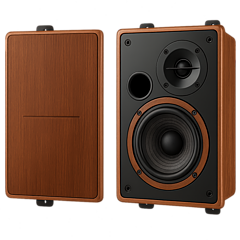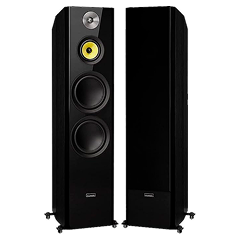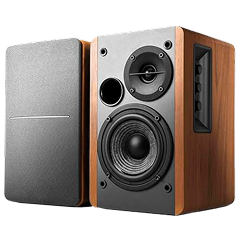In-wall speakers offer a sleek, unobtrusive way to enjoy high-quality sound without taking up floor or shelf space. While passive in-wall speakers are more common, active models are increasingly available and combine discretion with convenience and amplified performance.
Choosing the right in-wall design requires understanding a few additional factors beyond those considered for free-standing or passive speakers, particularly when it comes to power, connectivity, and installation.
How Do I Power My Speakers?
It’s tricky enough to wire a passive in-wall speaker to an external amplifier — but at least all that’s required is one length of reasonably unobtrusive speaker cable, which should be relatively easy to conceal.
Powered or active in-wall speakers, though, require a source of power. If it’s battery power, the things are reasonably straightforward. Either the speaker will have been designed to be easily removed from its wall cavity to have its batteries changed, or it will feature a USB input in order to power its rechargeable battery. Neither of these solutions are elegant, especially if you end up compromising your wall by repeatedly removing and refitting a speaker — but at least the processes themselves are not too taxing.
If your favoured speakers are mains-powered, though, things get a little trickier. Without the help of a qualified electrician, it won’t be possible to access mains power from inside a wall cavity — so there’s an expense there that needs to be budgeted for, as well as a lot of fiddling about at the point of initial installation. Otherwise, making a neat connection to a regular mains socket is almost certain to need the help of someone who is able to ‘chase in’ and conceal mains cable to ensure the whole point of your in-wall speakers isn’t compromised by unsightly lengths of cabling.
Wi-Fi Practicalities
Unlike the more traditional active bookshelf or floorstanding loudspeakers, where Bluetooth is a necessity and wi-fi connectivity a ‘nice to have’, you may well consider the ability to connect wirelessly to your router to be essential when it comes to powered/active in-wall speakers.
After all, you may not want your smartphone to be completely tied up by streaming via Bluetooth to your speakers. Wi-Fi connectivity will allow you to stream from music streaming service apps or access music stored on a common local network. As long as your wi-fi router is capable of covering the area of your home in which you wish to position your speakers, of course… if it’s not, you’ll need to invest in a Wi-Fi ‘extender’.
The Importance of Listening
Just as with every category of loudspeakers we discuss, listening before buying a pair of active in-wall loudspeakers is important. In fact, it’s very important indeed – because once you’ve gone to the time, the trouble and the expense of fitting and powering your in-wall speakers, there’s no turning back — or at least, turning back will be a tremendous pain in the neck.
So if at all possible, locate a dealer with the ability to replicate the effect of hearing the speakers when they’re in a wall with a void behind it. Otherwise you’re going to be making a big effort without any real idea of what the results might be.
Cutout Dimensions & Wall Space Requirements
Even if a powered or active in-wall speaker looks compact, the actual space it needs behind your wall can be larger than expected. Most models require a minimum wall depth of around 3–4 inches for a standard 6.5-inch woofer, while larger designs with 8-inch or 10-inch drivers may need 5 inches or more. Check the cutout dimensions carefully, including any brackets or mounting hardware, so you know whether the speaker will fit your wall cavity without interfering with studs, wiring, or plumbing. This ensures the installation is both practical and secure.
Frequency Response Expectations
Frequency response gives you an idea of how low and high the speaker can go. For most powered in-wall models, expect a low-frequency extension down to 40–50Hz for smaller designs. Larger models may reach closer to 30Hz, producing deeper and more impactful bass. The high-frequency range should extend to at least 20kHz to capture the full treble spectrum. Keep in mind that these numbers indicate potential output under ideal conditions; room acoustics and placement will influence the perceived performance.
Amplification & Wattage Benchmarks
The built-in amplifiers of powered or active in-wall speakers vary in power output. Smaller models typically deliver 30–50 watts RMS per channel, suitable for medium-sized rooms. Larger models often offer 70–100 watts RMS per channel or more, which is ideal for bigger spaces or when you want a fuller, louder sound without distortion. Make sure the amplifier’s output matches your listening environment; overpowered speakers can stress the drivers, while underpowered models may struggle to fill the room evenly.
Connectivity & Input Options
Consider how you plan to connect your speakers. Most entry-level powered in-wall models offer Bluetooth, with the current standard being v5.4. Bluetooth codecs like aptX or aptX Lossless provide better audio fidelity than older codecs. Higher-end active speakers also include Wi-Fi, allowing you to stream from networked music services without tying up your phone. Check for physical inputs if you want to connect a turntable, CD player, or TV via HDMI ARC. Ensuring the speaker supports the sources you actually use will save headaches later.
Tweeter & Driver Positioning Options
Because in-wall speakers are fixed, the ability to adjust tweeters is valuable. Pivotable tweeters allow you to direct high frequencies toward the listening area, improving stereo imaging and soundstage. Look for models that allow at least a 10–15° adjustment. If the tweeters are fixed, consider the listening position carefully, as small changes in direction can significantly affect clarity and detail.
Grille Options & Aesthetics
Grilles are not just about looks; they also protect the drivers. Ideally, grilles should sit flush with the wall and attach magnetically for a clean, unobtrusive appearance. Some models offer paintable grilles, allowing you to match the wall color. Avoid speakers that require screw-on grilles that leave visible holes, especially if you care about aesthetics.



















